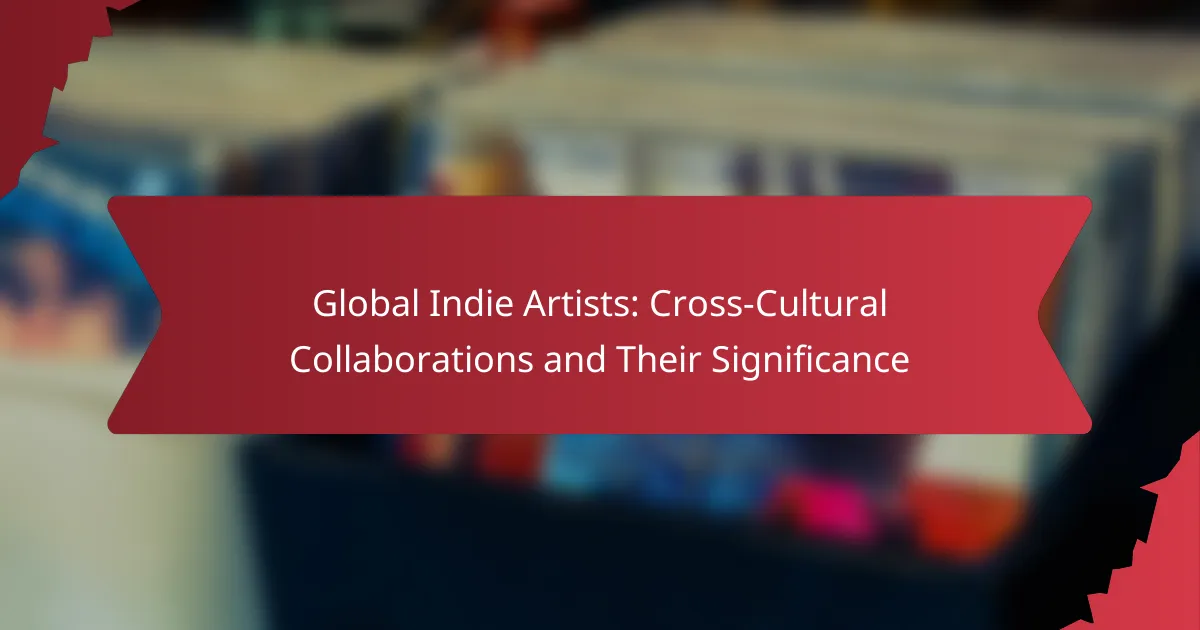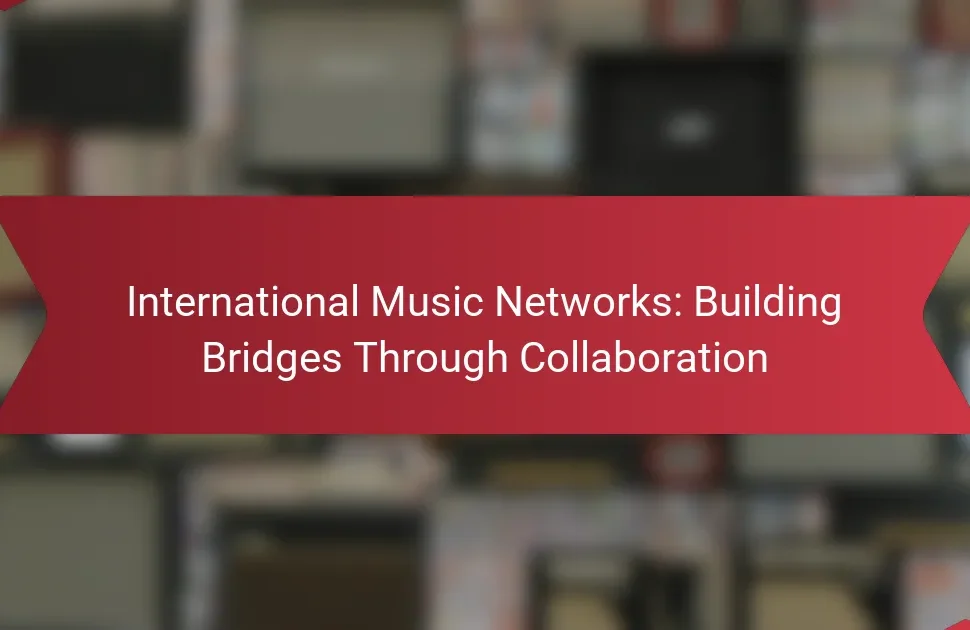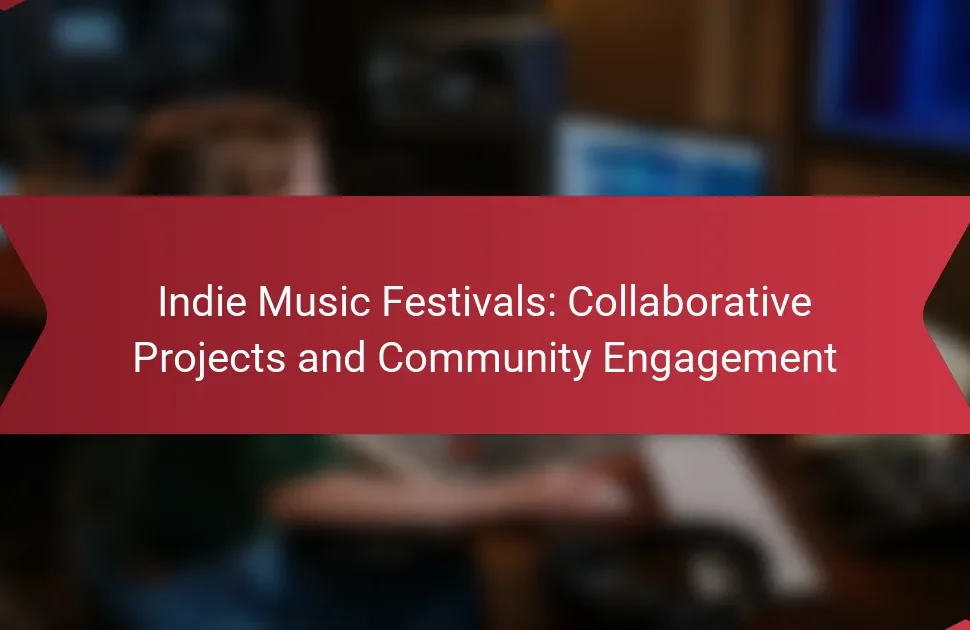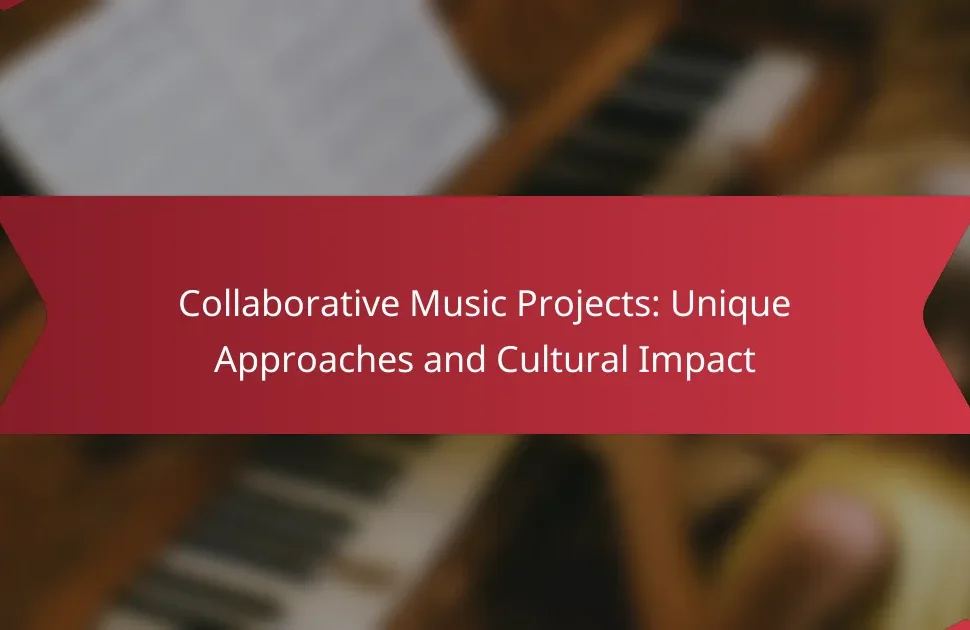Cross-cultural collaborations among global indie artists enhance creativity and broaden audience reach. These partnerships leverage social media, music festivals, and collaborative albums. They also face challenges like communication barriers and differing artistic expectations. Successful collaborations promote cultural exchange and authenticity, enriching the global music scene.
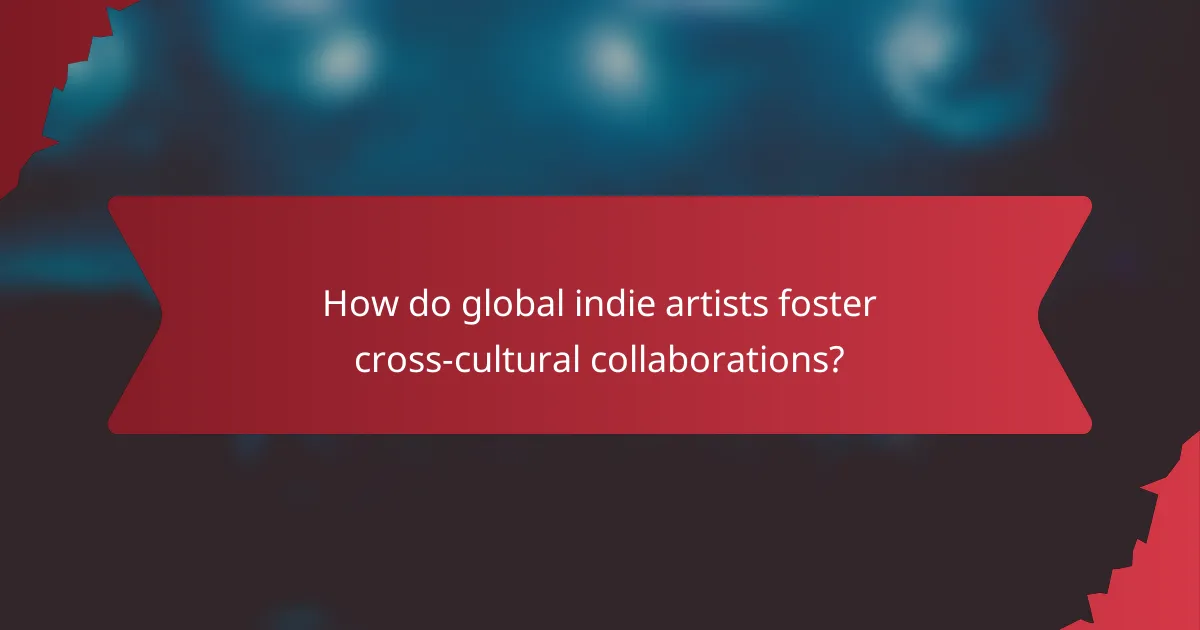
How do global indie artists foster cross-cultural collaborations?
Global indie artists foster cross-cultural collaborations through shared platforms, innovative projects, and cultural exchange. These collaborations enhance creativity and broaden audience reach. Artists utilize social media, music festivals, and collaborative albums to connect globally. For example, a project may involve artists from different countries blending genres, resulting in unique soundscapes that reflect diverse cultural influences. Such partnerships not only enrich the music but also promote understanding and appreciation among different cultures.
What are the motivations behind these collaborations?
Collaborations among global indie artists are motivated by cultural exchange, artistic innovation, and audience expansion. These partnerships enable artists to blend diverse musical styles, enriching their creative output. Collaborations also foster community building, allowing artists to share resources and insights. Additionally, they enhance visibility in new markets, driving growth and engagement with wider audiences.
Which platforms facilitate cross-cultural partnerships among indie artists?
Platforms that facilitate cross-cultural partnerships among indie artists include Bandcamp, SoundCloud, and Spotify. These platforms enable collaboration through diverse features such as global reach, community engagement, and music sharing capabilities.
Bandcamp allows artists to connect directly with fans and fellow musicians worldwide, fostering unique collaborations. SoundCloud offers tools for feedback and networking, promoting cross-cultural exchanges. Spotify’s playlists and algorithm-driven recommendations enhance visibility for indie artists, bridging cultural gaps.
Additionally, social media platforms like Instagram and TikTok play crucial roles in promoting cross-cultural partnerships by allowing artists to showcase their work and collaborate creatively with a global audience.
How do cultural differences influence collaborative processes?
Cultural differences significantly shape collaborative processes among global indie artists. These variations influence communication styles, creative expressions, and decision-making approaches.
For instance, artists from collectivist cultures may prioritize group harmony, affecting collaboration dynamics. Conversely, those from individualistic cultures may emphasize personal expression, leading to diverse creative outcomes.
Understanding these cultural nuances fosters respect and adaptability, enhancing collaboration’s overall effectiveness. Successful cross-cultural projects often emerge from balancing these differing perspectives, ultimately enriching the artistic process.

What are the benefits of cross-cultural collaborations for indie artists?
Cross-cultural collaborations significantly enhance the creativity and reach of indie artists. These partnerships foster diverse perspectives, leading to innovative soundscapes and artistic expressions.
Collaborating with artists from different backgrounds allows indie musicians to tap into new markets, broadening their audience. This exposure can lead to increased streaming numbers and fan engagement.
Additionally, cross-cultural collaborations often result in unique genre fusions, creating fresh music that resonates with a wider demographic. Such collaborations can also promote cultural exchange, enriching the artistic community.
Finally, these partnerships can provide valuable networking opportunities, connecting indie artists with industry professionals and resources that may not have been accessible otherwise.
How do these collaborations enhance artistic diversity?
Collaborations among global indie artists enhance artistic diversity by blending unique cultural influences. These partnerships foster innovation and creativity, leading to new sounds and styles. Cross-cultural exchanges expand audiences, allowing artists to reach and resonate with diverse communities. Ultimately, such collaborations enrich the global music landscape, promoting inclusivity and understanding.
What economic advantages do global collaborations offer to indie artists?
Global collaborations offer indie artists economic advantages through expanded market access and increased revenue streams. These partnerships enhance visibility in diverse cultural contexts, attracting varied audiences. Collaborative projects can lead to shared resources, reducing individual costs for production and marketing. Additionally, they foster innovation, allowing artists to create unique works that resonate across different demographics, potentially increasing sales and streaming revenue.
How do cross-cultural projects expand audience reach?
Cross-cultural projects significantly expand audience reach by blending diverse musical influences and attracting varied demographics. These collaborations introduce global indie artists to new markets, enhancing their visibility and fan engagement. By merging different cultural elements, artists can create unique sounds that resonate with wider audiences. This approach not only broadens their listener base but also fosters cross-cultural appreciation and dialogue.
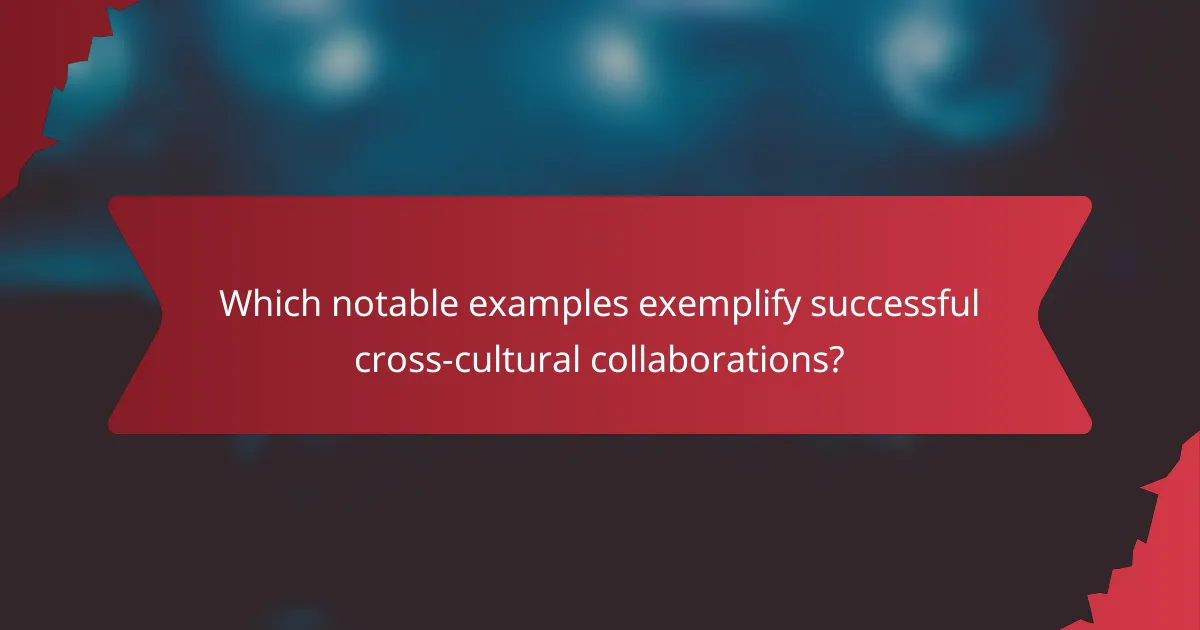
Which notable examples exemplify successful cross-cultural collaborations?
Notable examples of successful cross-cultural collaborations include the partnership between the American artist Pharrell Williams and the Japanese designer Nigo. Their work on the Billionaire Boys Club brand blends Western and Eastern influences. Another example is the collaboration between the Colombian singer Shakira and the American rapper Wyclef Jean, which showcases a fusion of Latin and hip-hop styles. The British band Coldplay collaborated with the Indian musician A.R. Rahman, resulting in a unique sound that bridges cultural gaps. These collaborations highlight the significance of cultural exchange in the global music scene.
What lessons can be learned from specific collaborative projects?
Collaborative projects among global indie artists teach valuable lessons about cultural exchange and creativity. They highlight the importance of diverse perspectives in enhancing artistic expression.
Successful collaborations often reveal the significance of adaptability and open-mindedness. For instance, artists learn to navigate different cultural contexts, which can lead to innovative music styles and unique sounds.
Moreover, these projects foster community building across borders, creating networks that support emerging talents. Artists gain insights into marketing strategies and audience engagement through shared experiences.
Finally, collaborations can amplify social messages, demonstrating how art can address global issues. This collective approach enhances the impact of their work, resonating with wider audiences.
How do collaborations between artists from different regions differ in style and impact?
Collaborations between artists from different regions often showcase distinct styles and cultural influences. These partnerships blend diverse musical traditions, resulting in unique soundscapes that reflect various cultural backgrounds.
For instance, artists from Africa may incorporate traditional rhythms into contemporary genres, while European artists might introduce intricate melodies. This fusion not only enriches the music but also broadens the audience’s appreciation for global sounds.
The impact of these collaborations extends beyond music. They foster cultural exchange, promote understanding, and create a sense of unity among diverse communities. The significance of such collaborations lies in their ability to challenge stereotypes and highlight the beauty of diversity in artistry.
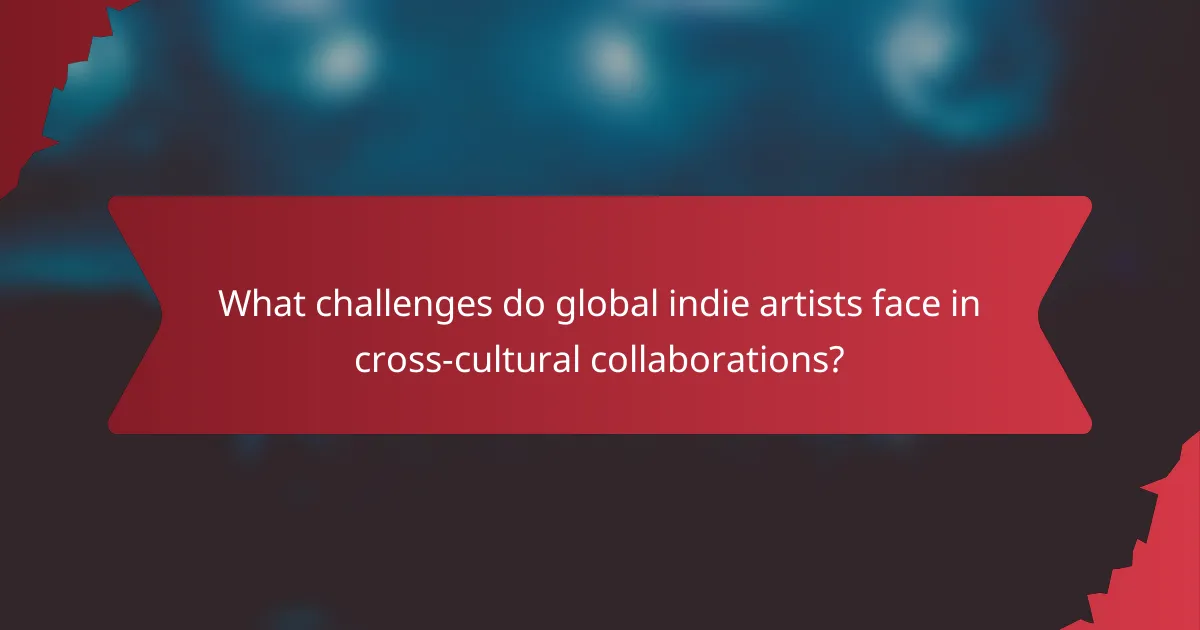
What challenges do global indie artists face in cross-cultural collaborations?
Global indie artists face significant challenges in cross-cultural collaborations, including communication barriers, cultural misunderstandings, and differing artistic expectations. These obstacles can hinder creative synergy and project success. Artists often struggle to find common ground in their creative processes, which can lead to frustration and misalignment. Additionally, logistical issues such as time zone differences and varying industry standards can complicate collaborations.
How do language barriers affect collaboration outcomes?
Language barriers significantly hinder collaboration outcomes among global indie artists. Miscommunication can lead to misunderstandings, reduced creativity, and weakened relationships. Effective collaboration relies on clear communication, and language differences can obstruct this process. Artists may struggle to convey their ideas, resulting in less impactful projects. Additionally, cultural nuances in language can further complicate interactions. Overcoming these barriers often requires translation services or bilingual collaborators, enhancing mutual understanding and fostering successful partnerships.
What role does cultural appropriation play in these partnerships?
Cultural appropriation can complicate partnerships between global indie artists by raising ethical concerns. It often involves adopting elements from one culture by another, which can lead to misunderstandings and tensions. For instance, artists may unintentionally exploit cultural symbols without proper context or respect. This can result in backlash from the originating culture, impacting collaborations. Acknowledging and respecting cultural origins fosters genuine partnerships. Successful collaborations often highlight shared values and mutual respect, enhancing the significance of cross-cultural exchanges.
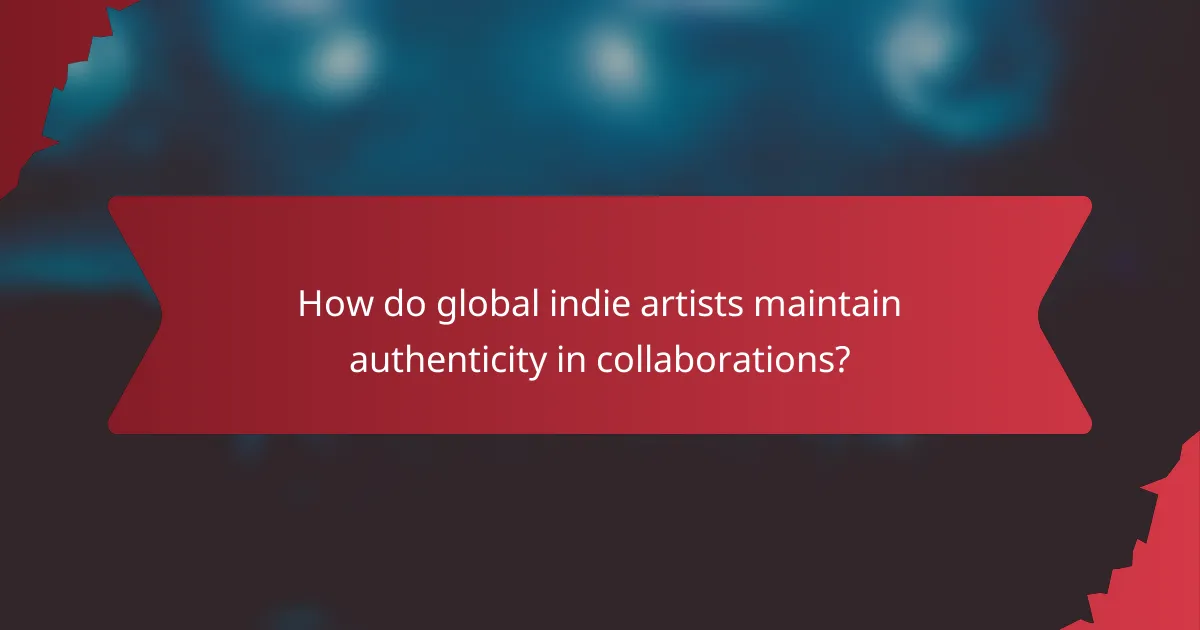
How do global indie artists maintain authenticity in collaborations?
Global indie artists maintain authenticity in collaborations by prioritizing personal expression and cultural integrity. They often select partners who share similar values and artistic visions. This alignment fosters genuine creativity and mutual respect, essential for authentic collaborations. Additionally, artists leverage their unique backgrounds to infuse diverse influences into their music, enriching the collaborative process. By balancing their individual identities with the collaborative spirit, they create works that resonate deeply with audiences across different cultures.
What strategies do artists use to respect cultural heritage?
Artists use various strategies to respect cultural heritage, including collaboration with local communities, incorporating traditional techniques, and promoting cultural awareness. These actions foster mutual respect and understanding among diverse cultures.
Collaborative projects often involve artists from different backgrounds working together, which helps preserve and celebrate cultural identities. For instance, cross-cultural music collaborations can blend traditional sounds with contemporary styles, creating new art forms that honor heritage while appealing to modern audiences.
Additionally, many artists engage in research to understand the historical and social contexts of the cultures they represent. This deepens their work and ensures authenticity. By showcasing traditional art forms and storytelling methods, they contribute to the preservation of these practices.
Promoting cultural awareness through art exhibitions, workshops, and community events also plays a crucial role. These initiatives educate audiences about cultural significance and encourage appreciation for diverse heritages.
How do artists balance commercial success with artistic integrity?
Artists often navigate the tension between commercial success and artistic integrity by prioritizing authenticity. Many indie artists engage in cross-cultural collaborations, enriching their work while appealing to diverse audiences. This approach can enhance their marketability without compromising their core values. By selecting partners who share similar artistic visions, they maintain creative control while expanding their reach. Balancing these aspects is crucial for sustaining both their artistry and financial viability in a competitive landscape.
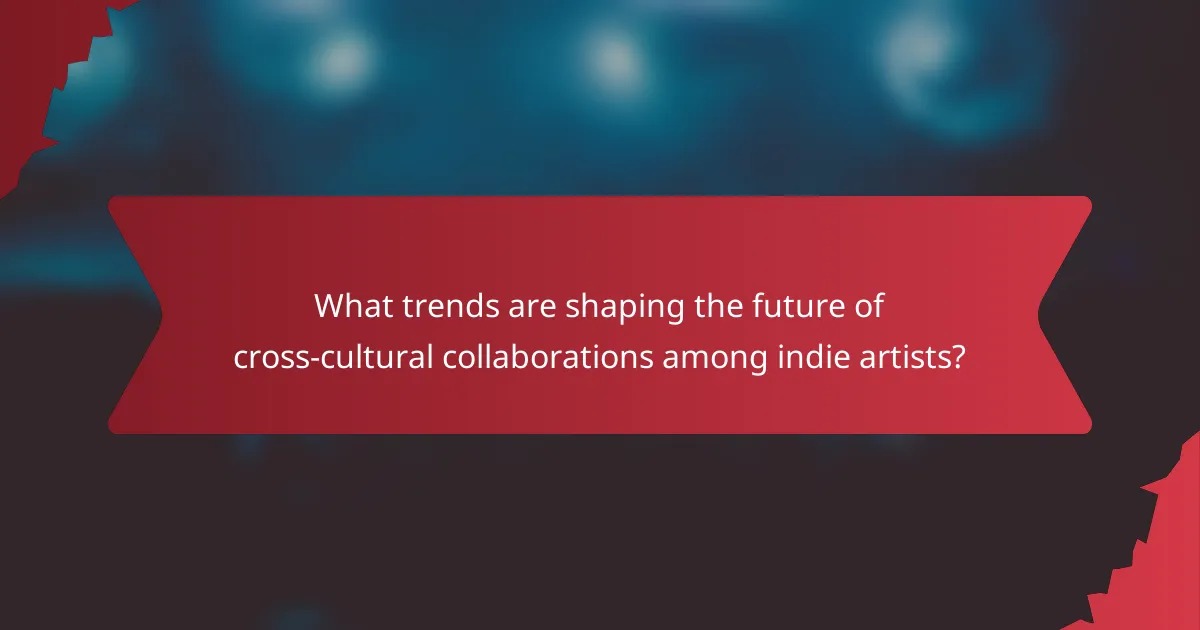
What trends are shaping the future of cross-cultural collaborations among indie artists?
Cross-cultural collaborations among indie artists are increasingly shaped by technology, cultural exchange, and social movements. Digital platforms enable artists to connect globally, fostering diverse creative expressions. Collaborative projects often reflect shared social issues, promoting unity and understanding. As a result, these collaborations enhance the visibility and reach of indie artists, allowing unique cultural narratives to emerge.
Which emerging technologies are influencing collaborative practices?
Emerging technologies such as artificial intelligence, blockchain, and virtual reality are significantly influencing collaborative practices among global indie artists. These technologies enhance cross-cultural collaborations by facilitating seamless communication, ensuring secure transactions, and creating immersive experiences.
AI-driven tools allow artists to co-create music and art across borders, while blockchain provides transparency in royalties and ownership. Virtual reality platforms enable collaborative performances and experiences, transcending geographical limitations. As a result, artists can connect and innovate together, enriching the global indie music scene.
How are social movements impacting the themes of cross-cultural collaborations?
Social movements significantly enhance cross-cultural collaborations among global indie artists. They foster awareness of social issues, encouraging artists to unite across borders. This collaboration leads to diverse musical expressions, blending cultural influences. The unique attributes of these movements, such as activism and community engagement, inspire artists to create impactful works that resonate globally. As a result, social movements shape the themes and narratives within the music, promoting solidarity and understanding among different cultures.
What predictions can be made for the evolution of global indie collaborations in the coming years?
Global indie collaborations will increasingly leverage technology, blending diverse musical styles and expanding audiences. Artists will focus on cross-cultural themes, enhancing creativity and social impact. The rise of digital platforms will facilitate these partnerships, allowing for real-time collaboration and global reach. As a result, indie music will become more inclusive, reflecting a wider array of cultural influences and fostering community engagement.
What best practices can indie artists adopt for successful cross-cultural collaborations?
Indie artists can enhance cross-cultural collaborations by prioritizing open communication and mutual respect. Understanding cultural differences fosters creativity and innovation.
1. Research cultural contexts to avoid misunderstandings.
2. Establish clear goals and expectations from the start.
3. Leverage technology for seamless collaboration across time zones.
4. Be open to diverse artistic expressions and styles.
5. Share personal stories to create emotional connections.
6. Celebrate cultural diversity through joint projects.
